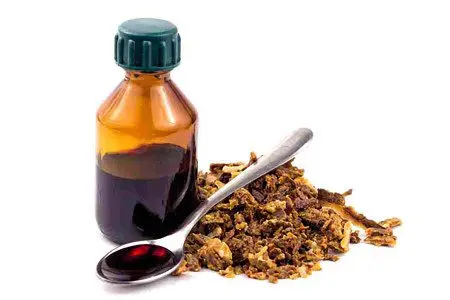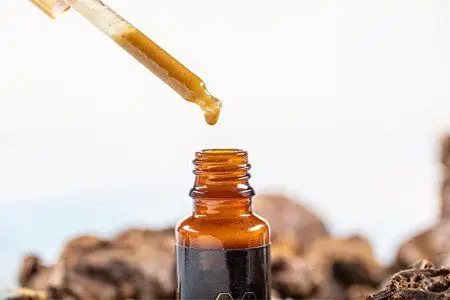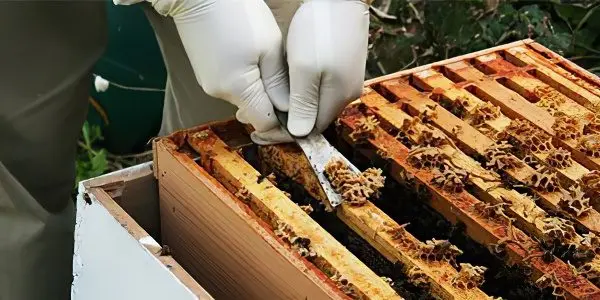Contents
Propolis is mentioned in ancient Egyptian manuscripts, the Talmud and the Bible. He was credited with healing, supernatural, almost sacred qualities. Throughout the history of medicine, propolis has been used as a means to strengthen the immune system, treat infections, and improve health in type II diabetes. This article focuses on the unique properties, recommended dosages based on scientific research, and the likely side effects of propolis.
What is propolis?
This is bee glue, i.e. substance produced by worker bees.
Propolis performs certain functions in the hive:
closes gaps;
if necessary, blocks the entrance – letok;
closes the honeycomb with “lids” – zabrus;
disinfects cells, maintains sterility in the hive;
envelops foreign, potentially dangerous objects that enter the hive.
Propolis is able to stick together particles, because bees create it from sticky substances collected in the spring from the buds of black poplar, alder, warty birch, aspen and other trees. This “harvest” insects are additionally processed with their enzymes.
Bee glue has a very complex chemical composition. It includes 16 classes of organic substances! Perhaps this is the reason for such a variety of properties of this beekeeping product. It consists of various resins, oils, alcohols, proteins, as well as wax, pollen, vitamins, sugar and other ingredients.
Propolis is a substance that is unusual in its method of preparation, composition, and has unusual properties.
Against the background of increased interest in propolis, scientific research was initiated. They have shown that bee glue has a beneficial effect on bone density, skin regeneration processes, liver health and helps to normalize high blood pressure. [1].
Composition of propolis: bioactive compounds

The composition of propolis, the concentration of chemical compounds depend on the region where the apiary is located, the surrounding flora, and the type of bees. In some cases, the difference in biochemical composition is observed even in neighboring hives.
Natural propolis emits a sweetish-tart smell, organic substances give it a characteristic green, yellow-brown or dark brown color.
Propolis contains: [2], [3]
50-70% resins.
30-50% beeswax.
5-10% pollen.
5-10% essential oils of basil, geranium or thyme, depending on the geographical location.
5-7% of other biochemical compounds – vitamins B, C, E, sugars, amino acids.
It has been established that the main active substance of propolis is chrysin, a plant flavonoid that is able to withstand the destructive action of free radicals. Bees get chrysin from flowers, different parts of plants. During the production of propolis, bees mix the harvested plant material, pollen, with their saliva and beeswax.
More than 300 biochemically active compounds have been found in propolis through laboratory studies, including:
Fragrant ingredients.
Acids.
Carbohydrates.
Vegetable oils.
Vitamins B1, B2, C, E.
The growing interest in propolis explains new research, the discovery of new types of bee glue.
The effectiveness of propolis has been proven: studies

Propolis contains a lot of bioactive substances, antioxidants, thanks to which it is able to have an almost comprehensive therapeutic effect on the body.
Of the main effects of propolis, it is worth highlighting:
Ability to stop the growth, spread of viruses and bacteria [4], [5], [6].
Activity against yeast infections, inhibition of growth, reproduction of fungi [7].
Inhibition of histamine release, direct anti-allergic effect [8].
Suppression of the activity of tyrosine hydroxylase, an enzyme that affects the rise in blood pressure [9]. The mechanism implements the hypotensive effect.
Increased bone density, ability to heal fractures, improve bone health [10].
Stimulates skin regeneration in case of wounds, has rejuvenating properties [11].
Counteracting the growth of altered tumor cells, participation in the mechanism of apoptosis [12], [13].
Protection of liver hepatocytes from toxins, pathogens [14].
Strengthening teeth, neutralizing carious processes, improving the condition of the oral mucosa by destroying pathogenic flora, eliminating swelling of the gums [15].
Reduces blood sugar levels, improves well-being in diabetes [16].
Useful and medicinal properties of propolis

Using propolis, bees protect the hive from bacterial flora, cover waste with it, which blocks the reproduction of pathogens and parasites. [17]. The active components of bee glue destroy bacteria, fungi, viruses and parasites when applied externally and internally.
The medical literature describes in detail the valuable properties of European and Brazilian propolis. Observation of 30 children showed that rinsing the mouth with propolis is effective in bacterial lesions of the mucous membrane, elimination of dental plaque [18], [19], [20], [21].
Clinical trials of an ointment with propolis were carried out with the participation of 90 patients with genital herpes. As a result, it turned out that the bee product is more effective than the antiviral ointment Acyclovir, which was used in the placebo group. In addition, a study was conducted with the participation of 200 people with herpetic rashes on the lips. Here, too, lipstick with propolis showed greater effectiveness than Acyclovir. [22], [23].
Laboratory experiments with mice have shown that propolis enhances the therapeutic activity of antifungal, antibacterial and antiviral drugs. Natural compounds of bee glue literally attack pathogens, completely blocking their ability to reproduce and develop. [24], [25].
In relation to yeast and fungal processes, propolis has a blocking effect. This is expressed in the loss of the ability of microorganisms to form colonies inside the body. One study involved 707 people with fungal infections of the nails on their hands. Each of them treated the nails with propolis extract. Six months later, a complete recovery was established in more than 50% of the subjects. It turned out that propolis penetrates into all layers of the nail and destroys the membranes of the pathogen fungus. [26].
Laboratory experiments have shown that propolis inhibits the formation of yeast clusters at the cellular level. Fungi are surrounded by biofilms that are needed for fixation to the surface of the body. The destruction of these biofilms prevents the development of a yeast infection. Propolis has activity against fungi of the genus Candida [27], [28].
The effect of propolis against infections is currently being studied. Available data suggest that it may have a positive effect in a number of diseases of a bacterial or viral nature. The feasibility of using propolis in combination with traditional therapy should be discussed with your doctor. It is important to remember that propolis does not replace specific drugs that are prescribed for infectious diseases.
2 Maintains oral health
The first mention of the use of propolis for filling teeth dates back several thousand years. For example, ancient skeletons with beeswax and propolis fillings were found in Slovenia. It is established that one of them is at least 6500 years old. It is safe to say that propolis fillings are the earliest form of dentistry.
Several studies have been organized to investigate the effects of propolis on oral health. Two of them involved 6 adults and 70 children without dental diseases. The results showed that mouthwash with propolis inhibits the formation of plaque and reduces the number of bacteria. [29], [30].
One of the experiments was organized by dental students. For two weeks they used propolis and herbal toothpaste. Its effectiveness surpassed the ability of commercial toothpaste to remove plaque [31].
Clinical trials of chewing gum with propolis were carried out with the participation of 30 healthy children. The final data showed that it reduces the concentration of Streptococcus mutans in saliva – microbes that cause tooth decay. [32].
31 patients in the rehabilitation period after a jaw fracture took part in clinical trials of propolis green gel. The results showed that the drug eliminates the pathogenic flora associated with the development of gum disease and caries. It is noteworthy that in this case, the preservation of beneficial microflora of the oral cavity is observed. [33].
Mouthwashes, dental gels help in the treatment of gum disease. This was confirmed by the data of two studies in which 78 people took part. A 20% solution of propolis for irrigation of the gums is a good addition to the traditional treatment of oral mucosal problems. Efficiency confirmed by a small experiment involving 16 patients [34], [35].
More than 100 people have taken part in clinical trials of propolis for oral use. It turned out that the remedy promotes the healing of ulcers on the mucous membranes with aphthous stomatitis [36], [37].
Controversial data have been obtained regarding the action of propolis in oral mucositis. This condition is characterized by the appearance of ulcers on the oral mucosa during chemotherapy or radiation treatment. Several clinical studies in which 214 patients with various forms of cancer participated showed improvement, healing of the affected mucous cheeks and gums. However, two other observations of 100 adults and 50 children did not show similar efficacy. [38], [39].
An analysis of all studies suggests that propolis helps maintain oral and dental health. Methods of its use, dosage should be discussed with the doctor conducting the main treatment.
3 Controls sugar levels in type II diabetes
The study of the effect of propolis on the course of type II diabetes mellitus took place both in animals and in humans. It turned out that bee glue is able to control and, if necessary, lower blood glucose levels.
At least 250 patients with established type II diabetes participated in four studies. Each of them took propolis at a dosage of 400 to 1500 mg per day. The final analyzes showed a pronounced antioxidant protection and a decrease in blood glucose levels. [40], [41], [42], [43].
A significant proportion of patients with diabetes mellitus (15%) suffer from complications in the form of a diabetic foot. This condition is characterized by the formation of trophic ulcers on the feet. A high concentration of glucose in the blood inhibits the healing process. Against the background of ulcers, severe infectious lesions often develop, which can lead to limb amputation. Topical application of propolis stimulates the regeneration of diabetic foot ulcers, as proven in two studies involving 64 patients [44], [45].
Some doctors believe that the data on the benefits of propolis in diabetes is not enough. Therefore, propolis-based products should be included in complex therapy only after consultation with your doctor.
4 Has an antioxidant effect
The study of the antioxidant properties of propolis was mainly carried out on cells and animals. Recent human observations have confirmed these qualities.
One clinical study involved 67 people who received 15 drops of Beepolis liquid propolis twice a day. In addition to having its own antioxidant properties, propolis has been found to increase levels of the body’s own antioxidant, glutathione. After a three-month course, the subjects had an increase in HDL (good cholesterol), which greatly contributed to a decrease in the risk of heart disease. [46].
In another study, 47 participants received propolis powder at 50 mg per day. One month later, the results showed that the flavonoids contained in propolis reduced the symptoms of oxidative stress in men by 23%. [47].
A study of 100 patients with type II diabetes mellitus confirmed an improvement in antioxidant status.
5 Lowering blood pressure
To study the hypotensive effect of propolis, a study was conducted involving 35 patients with high blood pressure. The subjects received propolis twice a day for 3 months. As a result, there was a slight decrease in the numbers of systolic and diastolic pressure. [48].
Observations on rats have shown that propolis reduces high blood pressure by blocking the action of the enzyme responsible for pressure – tyrosine hydroxylase. This effect prevents damage to the heart [49].
One human trial and a couple of studies in rats are not enough to firmly believe that propolis helps with hypertension, larger studies are needed.
6 Allergies
At the heart of the body’s response to seasonal allergies, eczema, asthma is the hyperactivation of mast cells, followed by the release of histamine. An experiment on mice showed that the propolis flavonoid quercetin blocks the release of histamine, alleviates the symptoms of allergies. [50], [51].
Preparations based on propolis affect the balance of Th1 (humoral) and Th2 (cellular) immune response. It is dangerous for patients with Th1-dominance to get involved in propolis, so as not to cause hyperactivation of the immune system.
7 Wound treatment
Cell and animal studies have shown that propolis-based products can stimulate the healing of superficial wounds by growing new dermal cells.
Observation of mice showed that propolis accelerates regeneration in case of superficial damage, activates collagen synthesis, and expresses genes for the antioxidant glutathione. [52].
8 Maintaining bone health
An experiment on rats showed that the active components of propolis stimulate the formation of new bone tissue cells. [53]. Bee glue can increase bone density, keep them healthy, especially after injuries.
9 Liver protection.
Substances contained in propolis protect liver hepatocytes from the destructive effects of alcohol. Animal and cell studies show that bee glue prevents the development of liver fibrosis. The results of one of the experiments showed that propolis extract reduces liver damage caused by the systematic use of ethanol. [54].
10 Antitumor effect
Propolis has potential anti-cancer activity, according to preliminary studies. However, we must not forget that many chemical compounds, including dangerous, toxic ones, can kill a cancer cell, but this does not mean that each of them is approved by medicine. As clinical practice shows, most natural and synthetic substances do not have the proper efficacy and safety.
The active elements of propolis do not allow the changed cells to form young blood vessels. Without food and oxygen, cancer cells die, the tumor stops growing. Not all propolis compounds are stable and need some optimization. Only then can positive anti-cancer effects be expected. Animal Study Confirms Optimized Propolis Actives Kill Cancer Cells [55].
Propolis tincture

Propolis has a unique quality – even after treatment with high temperatures, it does not change its properties. This allows the production of a wide variety of propolis-containing products. The tincture always contains alcohol, and is called so because it is insisted, “soaked” without heating for some time. Propolis is difficult to use in its original form, because it is quite dense and becomes soft only when heated. “Soak” it under the force of only alcohol-containing solutions. They allow you to achieve maximum extraction of nutrients.
What does propolis tincture treat?
This drug is taken to treat various diseases of the gastrointestinal tract, tumors, skin, respiratory tract, circulatory and genitourinary systems, and more. This is the versatility of propolis.
A miraculous natural remedy treats almost any disease, has a beneficial tonic effect on the entire body. Any ailment is caused by a malfunction in the body, which can occur due to the ingress of harmful substances from the outside or internal disturbances.
Propolis tincture treats almost all types of diseases, including those caused by:
physical causes – injuries, burns. Accelerates regeneration processes, prevents the onset of the inflammatory process, prevents infection.
chemical – poisoning. Removes toxins from the body.
biological – infectious diseases. Kills harmful microorganisms, promotes their removal.
social – chronic fatigue, alcoholism, drug addiction. Supports the body with a complex of minerals and vitamins, removes toxic substances.
deficiency of substances – avitaminosis. The composition of propolis includes vitamins of most groups.
A number of diseases for the treatment of which propolis tincture is used can be listed endlessly. It is much more difficult to name cases when it does not help.
How to make propolis tincture at home?

Before using the bond, it is recommended to first clean it by rubbing frozen propolis on a fine grater. Crushed bee glue is poured with cold water. Everything superfluous will float, the top layer with floating particles can be drained. The cleaned bee glue needs to be dried. As a solvent for infusion, medical alcohol, vodka or alcohol infusions of various herbs are used. The latter enhance the therapeutic effect.
To prepare a therapeutic composition, you can go the easy (fast) or difficult way. In the first case, the recipe is as follows: finely grate 10 g of propolis, heat 90-100 ml of 70% medical alcohol in a water bath to 50 degrees, mix everything until a homogeneous consistency, remove from heat without boiling, strain through special paper with cotton wool or several layers of gauze, pour into a dark glass dish, cork well. Store in a dark cool place.
Making a 10% tincture according to the second recipe will take more time, but it is easier. Pour alcohol or vodka into a glass dish, pour propolis into the same place. Infuse for 2 weeks in a dark, warm place, shaking 2 times a day. Strain and the medicine is ready.
The recipe depends on the concentration of the tincture to be prepared (5-50%). It is better to make a 50% composition, and then dilute it in the right proportions.
Video: a recipe for how to properly prepare propolis tincture:









